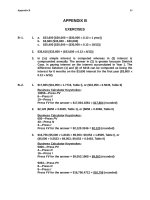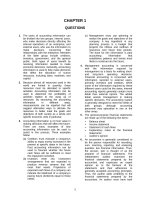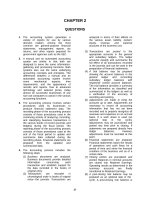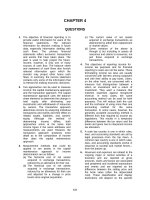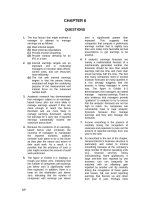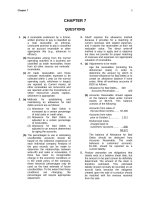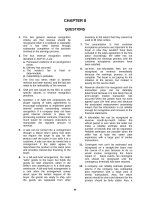Solutions manual intermediate accounting 18e by stice and stice ch10
Bạn đang xem bản rút gọn của tài liệu. Xem và tải ngay bản đầy đủ của tài liệu tại đây (259.48 KB, 44 trang )
To download more slides, ebook, solutions and test bank, visit
CHAPTER 10
QUESTIONS
1. a. The cost of land includes the original
purchase price; brokers’ commissions;
legal fees; title, recording, and escrow
fees; surveying costs; local government
special assessment taxes; cost of
clearing or grading; and other costs
that permanently improve the land or
prepare it for use. Expenditures for land
improvements that have a limited life,
such as paving, fencing, and landscaping, may be separately summarized as
land improvements and depreciated
over their estimated useful lives.
b. The cost of buildings includes the original purchase price, brokers’ commissions, legal fees, title and escrow fees,
reconditioning costs, alteration and improvement costs, and any other costs
that improve the buildings and hence
benefit future periods.
c. The cost of equipment includes the
original purchase price, taxes and duties on purchases, freight charges, insurance while in transit, installation
charges and other costs in preparing
the asset for use, subsequent improvements or additions, and any other
expenditures that will improve the
equipment and thus benefit more than
one period.
2. a. A copyright, when purchased, is recorded at its purchase price. When internally developed, all costs of legally
establishing the copyright are included
as costs of the copyright.
b. The cost of purchasing a franchise and
all other sums paid specifically for a
franchise including legal fees are considered the franchise cost. Property
improvements required under the franchise also are recorded as part of the
franchise cost.
c. The cost of a trademark includes all
expenditures required to establish the
trademark, such as filing and registration fees, as well as legal expenses for
the defense of the trademark. Pur-
3.
4.
5.
6.
381
chased trademarks are recorded at the
purchase price.
Accountants frequently are required to allocate costs among two or more accounts.
The principal method of allocation is based
on relative fair values of the individual assets, if they can be determined. A ratio of
each individual asset’s fair value to the sum
of the fair values for all assets involved in
the purchase is used to determine cost for
each individual asset. If fair values, or
some approximation of fair values, cannot
be obtained for all assets in the basket purchase, allocation can be made to those assets where fair values are available, and
any remaining balance can be allocated, on
some systematic basis, to remaining assets.
When equipment is purchased on a deferred payment contract, care must be
taken to exclude the stated or implicit interest from the purchase price. The asset
should be recorded at its equivalent cash
price. Interest on the unpaid contract balance should be recognized as interest expense over the life of the contract.
a. Sales practice for some products consistently inflates the list price that is initially assigned. Because most buyers
are aware of this practice, considerable
negotiations take place between buyers
and sellers before a market price is established. If accountants use the list
price without careful evaluation, values
could be inflated.
b. The goal of accounting for the acquisition of property and equipment is to record the acquisition at the equivalent
cash price or the closest approximation
to cash that can be obtained. This is
especially important when trade-ins are
involved.
a. In constructing a new building for its
own use, Gaylen Corp. will charge the
building with all costs incurred in connection with the construction activities.
These costs will include building costs
in the form of direct labor, direct mate-
To download more slides, ebook, solutions and test bank, visit
382
Chapter 10
rials, factory overhead, and any other
expenditures that can be identified with
the construction of the asset.
b. When a company constructs its own assets, there are two positions that may be
taken in assigning general overhead to
the cost of the asset: (1) Overhead may
be assigned to special construction just
as it is assigned to normal activities on
the grounds that both activities benefit
from the overhead; this would mean that
construction would be charged with the
increase in overhead arising from construction activities as well as a pro rata
share of the company’s fixed overhead.
(2) Only the increase in overhead may
be charged to construction on the
grounds that management decides to
construct its own assets after giving due
consideration to the differential or additional costs involved. An equitable allocation of the fixed overhead between
regular operations and construction affords no special favor to construction activities; on the other hand, a charge to
construction for only the increase in total
overhead grants no special concessions
to regular activities during the construction period.
7. Before interest charges are capitalized, a
construction project should be a discrete
project. Interest should not be capitalized
for inventories manufactured or produced
on a repetitive basis, for assets that are
currently being used, or for assets that are
idle and not undergoing activities to prepare them for use.
understated. Furthermore, subsequent
income will be overstated through the
failure to recognize depreciation, and
this misstatement will be accompanied
by misrepresentations of earnings-toassets and earnings-to-owners’-equity
relationships reflected on the financial
statements. Properties unconditionally
transferred should be recognized by
debits to asset accounts and a credit to
a revenue account in terms of the fair
market values of the properties acquired, and depreciation should be recognized in using such properties.
b. If the donation of the property is contingent upon certain conditions, the president’s position relative to the nonrecognition of the asset is proper until the
time the conditions are met. Until the
conditions are met, the fair value of the
conditional gift, along with a description
of the conditions, should be disclosed
in the notes to the financial statements.
10. Under IAS 41, biological assets, such as
cattle, fruit trees, and lumber forests, are
recorded in the balance sheet at their fair
value (less estimated selling costs) as of
the balance sheet date. Increases in this
fair value are recognized as gains, and decreases are recognized as losses.
11. An asset retirement obligation is a legal
obligation a company has to restore the site
of a piece of property or equipment when
the asset is retired. The estimated fair
value of the asset retirement obligation is
recognized as a liability and is added to the
cost of the asset when it is acquired.
8. Under IAS 23, a company capitalizes the
net amount of interest which is the gross
amount of interest, computed as under U.S.
GAAP, less the amount of investment income generated by borrowed construction
funds that are temporarily invested before
they are needed to pay for construction expenditures. Accordingly, the amount of interest capitalized under the international
standard is generally less than the amount
that would be capitalized under the U.S.
standard.
12. Many companies establish a minimum
monetary amount for recording expenditures as assets, even though the item purchased meets the definition of an asset.
The principal reasons for this are materiality and the cost involved in recording an
asset and depreciating it over its estimated
life. It is more expedient to expense these
smaller capital expenditures immediately,
thus avoiding the recordkeeping associated
with assets.
9. a. If the donation of the property by the
philanthropist is unconditional, the
president’s position cannot be defended. If the donation is not recognized, both assets and income will be
13. a. The cost of a depreciable asset incorrectly recorded as an expense will understate assets and owners’ equity for
the current year and for succeeding
years, but by successively decreasing
amounts until the asset no longer
To download more slides, ebook, solutions and test bank, visit
Chapter 10
makes a contribution to periodic revenue. Net income will be understated in
the first year by the excess of the expenditure over depreciation for the current period; net income in succeeding
years will be overstated by the amount
of depreciation charges applicable to
the asset that should be charged off as
expense.
b. An expense expenditure incorrectly
recorded as an addition to the cost of a
depreciable asset will overstate assets
14.
383
and owners’ equity for the first year and
for succeeding years, but by successively decreasing amounts until the
charge has been fully written off. Net
income will be overstated for the first
year by the difference between the recognized depreciation for the current period and the amount of the expenditure;
net income for succeeding years will be
understated by the depreciation charges
recognized in such periods.
Expenditure
Classification
Cost of installing machinery..........................................
Asset
Cost of unsuccessful litigation to protect patent...........
Expense
Extensive repairs as a result of a fire ...........................
Expense
Cost of grading land .....................................................
Asset
Insurance on machinery in transit ................................
Asset
Interest incurred during construction period ................. Asset (if interest added to construction
cost)
Expense (if interest charged to expense)
g. Cost of replacing a major machinery component.........
Asset
h. New safety guards on machinery .................................
Asset
i. Commission on purchase of real estate .......................
Asset
j. Special tax assessment for street improvements.........
Asset
k. Cost of repainting offices ..............................................
Expense
a.
b.
c.
d.
e.
f.
15. The remaining net book value of a component that is replaced is added to depreciation expense for the period.
16. a. Research activities are those used to
discover new knowledge that will be
useful in developing new products, services, or processes, or significantly improve an existing product or process.
Development activities seek to apply
research findings to develop a plan or
design for new or improved products
and processes. Development activities
include the formulation, design, and
testing of products, construction of prototypes, and operation of pilot plants.
b. Research and development costs are
generally expensed in the period incurred. An exception is when the expenditure is for equipment and facilities
that have alternate future uses beyond
the specific current research project.
This exception permits the deferral of
costs incurred for materials, equipment,
facilities, and intangibles purchased,
but only if the alternative future use can
be specifically identified. In addition,
software development costs are capi-
talized if they are incurred after technological feasibility has been established.
17. With the full cost method of accounting for
oil and gas exploration costs, the cost of
drilling dry holes is capitalized and amortized. With the successful efforts method,
only the exploratory costs associated with
successful wells are capitalized; the cost of
dry holes is expensed as incurred.
18. In general, the cost of internally generated
intangibles is expensed as incurred.
19. The five general categories of intangible
assets are as follows:
1. Marketing related.
2. Customer related.
3. Artistic related.
4. Contract based.
5. Technology based.
20. The two approaches used in estimating fair
values using present value computations
are the traditional approach and the expected cash flow approach. In the traditional approach, which is often used in
situations in which the amount and timing
of the future cash flows is determined by
contract, the present value is computed
To download more slides, ebook, solutions and test bank, visit
384
Chapter 10
using a risk-adjusted interest rate that incorporates expectations about the uncertainty of receipt of the future contractual
cash flows.
In the expected cash flow approach, a
range of possible outcomes is identified,
the present value of the cash flows in each
possible outcome is computed (using the
risk-free interest rate), and a weightedaverage present value is computed by
summing the present value of the cash
flows in each outcome, multiplied by the estimated probability of that outcome.
21. a. Goodwill may be reported properly as
an asset only when it is purchased or
otherwise established by a transaction
between independent parties.
b. Expenditures for advertising should not
be capitalized as goodwill. Some advertising expenditures may be deferred
if the costs applicable to future benefits
from such advertising can be determined objectively. Normally, however, it
is advisable to expense such expenditures because of the short-lived nature
of the benefits and because future
benefits may be difficult to estimate.
22. The fair value of acquired in-process research and development is recognized as
an asset when acquired as part of a business combination but as an expense when
acquired as a basket purchase outside a
business combination.
23. Recording noncurrent operating assets at
their current values represents a trade-off
between relevance and reliability. In the
United States, reliability concerns have resulted in the prohibition of asset write-ups. In
many countries around the world, accountants have learned to rely on the judgment of
professional appraisers who estimate the
current value of long-term assets.
24. Under the provisions of IAS 16, the credit
entry is to a revaluation equity account when
noncurrent operating assets are written up
to reflect an increase in market value. (The
important point is that the revaluation
amount is not to be reported as a gain in the
income statement.)
25. Under the provisions of IAS 40, a company
can elect to use a fair value approach in
which the investment property is reported in
the balance sheet at its fair value, and any
resulting gains or losses are reported in the
income statement.
26. The fixed asset turnover ratio is computed
as sales divided by average property, plant,
and equipment (fixed assets); it is interpreted as the number of dollars in sales
generated by each dollar of fixed assets.
27. As with all ratios, the fixed asset turnover
ratio must be used carefully to ensure that
erroneous conclusions are not made. For
example, fixed asset turnover ratio values
for two companies in different industries
cannot be meaningfully compared. Another
difficulty in comparing values for the fixed
asset turnover ratio among different companies is that the reported amount for property,
plant, and equipment can be a poor indicator
of the actual fair value of the fixed assets
being used by a company. Another complication with the fixed asset turnover ratio is
caused by leasing. Many companies lease
the bulk of their fixed assets in such a way
that the assets are not included in the balance sheet. This practice biases the fixed
asset turnover ratio for these companies
upward because the sales generated by the
leased assets are included in the numerator
of the ratio but the leased assets generating
the sales are not included in the denominator.
To download more slides, ebook, solutions and test bank, visit
Chapter 10
385
PRACTICE EXERCISES
PRACTICE 10–1 CATEGORIES OF TANGIBLE NONCURRENT OPERATING ASSETS
1.
2.
3.
4.
Land
Cost to purchase land .....................................................
Cost to purchase land .....................................................
Cost to prepare land for use ...........................................
Total...................................................................................
$ 85,000
50,000
10,000
$145,000
Buildings
Cost to construct building ..............................................
$132,000
Equipment
Cost to purchase equipment...........................................
Cost to ship and install equipment ................................
Cost of testing ..................................................................
Total...................................................................................
$ 30,000
1,000
1,750
$ 32,750
Land Improvements
Cost to construct parking lot and sidewalks ................
$ 10,000
PRACTICE 10–2
Equipment
Building
Land
Total
BASKET PURCHASE
$250,000
425,000
125,000
$800,000
(250,000/800,000) × $750,000
(425,000/800,000) × $750,000
(125,000/800,000) × $750,000
Allocated
Cost
$234,375
398,438
117,187
$750,000
(Note: Some rounding is necessary to ensure that the total allocated cost is
$750,000.)
To download more slides, ebook, solutions and test bank, visit
386
Chapter 10
PRACTICE 10–3
1.
DEFERRED PAYMENT
Equipment................................................................................
Discount on Notes Payable....................................................
Cash....................................................................................
Notes Payable ....................................................................
120,696
49,304
10,000
160,000
Business calculator keystrokes:
N = 8 years
I = 9%
PMT = $20,000
FV = 0 (There is no balloon payment associated with the note.)
PV = $110,696
2.
Notes Payable..........................................................................
Cash....................................................................................
20,000
Interest Expense .....................................................................
Discount on Notes Payable ..............................................
9,963
20,000
9,963
Interest expense: ($160,000 – $49,304) × 0.09 = $9,963
PRACTICE 10–4
EXCHANGE OF NONMONETARY ASSETS
Equipment ........................................................................................
Gain on Asset Exchange ........................................................
Land..........................................................................................
PRACTICE 10–5
97,300
62,300
35,000
COST OF A SELF-CONSTRUCTED ASSET
Cost of materials............................................................................................
Labor cost ......................................................................................................
Allocated overhead cost ($8,000,000/$4,000,000) × $600,000 ...................
Interest cost ...................................................................................................
Total.........................................................................................................
$ 400,000
600,000
1,200,000
140,000
$2,340,000
To download more slides, ebook, solutions and test bank, visit
Chapter 10
387
PRACTICE 10–6
CAPITALIZED INTEREST: SINGLE-YEAR COMPUTATION
January 1
May 1
November 1
Total
Amount
$100,000
200,000
300,000
$600,000
Applicable
Interest
Rate
10%
13
13
1.
Amount of capitalized interest = $33,833
2.
Cost of building = $600,000 + $33,833 = $633,833
PRACTICE 10–7
Months of
Avoidable
Interest
12/12
8/12
2/12
Capitalized
Interest
$10,000
17,333
6,500
$33,833
CAPITALIZED INTEREST: JOURNAL ENTRY
Building ............................................................................................
Interest Expense ($270,000 – $33,833) ..........................................
Cash..........................................................................................
33,833
236,167
270,000
Total interest: ($100,000 × 0.10) + ($2,000,000 × 0.13) = $270,000
PRACTICE 10–8
CAPITALIZED INTEREST: MULTIPLE-YEAR COMPUTATION
From Year 1
July 1
Total
Amount
$ 100,000
533,833
500,000
$1,133,833
Applicable
Interest
Rate
10%
13
13
Months of
Avoidable
Interest
12/12
12/12
6/12
1.
Amount of capitalized interest = $111,898
2.
Cost of building = $1,133,833 + $111,898 = $1,245,731
PRACTICE 10–9
Capitalized
Interest
$ 10,000
69,398
32,500
$111,898
ACQUISITION BY DONATION
Land ..................................................................................................
Revenue (or Gain) ...................................................................
111,000
111,000
To download more slides, ebook, solutions and test bank, visit
388
Chapter 10
PRACTICE 10–10
ACCOUNTING FOR AN ASSET RETIREMENT OBLIGATION
Mining Site........................................................................................
Cash..........................................................................................
800,000
Mining Site........................................................................................
Asset Retirement Obligation..................................................
72,489
800,000
72,489
Business Calculator Keystrokes:
FV = $200,000; I = 7%; N = 15 years → $72,489
PRACTICE 10–11
RENEWALS AND REPLACEMENTS
Heating/Cooling System .................................................................
Accumulated Depreciation—Buildings (old system)...................
Depreciation Expense .....................................................................
Buildings (old system)............................................................
Cash..........................................................................................
PRACTICE 10–12
(1)
(2)
(3)
160,000
210,000
RESEARCH AND DEVELOPMENT
Normal: Expense all—$120,000 + $100,000 = $220,000
Software: Expense amounts before technological feasibility: $120,000
International: Expense amounts before technological feasibility: $120,000
PRACTICE 10–13
(1)
(2)
210,000
128,000
32,000
OIL AND GAS EXPLORATION COSTS
Successful efforts: Expense all costs of dry holes = $400,000.
Full cost: Capitalize all costs, and amortize the amount to expense in subsequent years. Accordingly, expense for this year is $0. (Note: Because all costs
were incurred on the last day of the year, there is no amortization this year.)
PRACTICE 10–14
ACCOUNTING FOR THE ACQUISITION OF AN ENTIRE COMPANY
Cash price ..................................................................................
Fair value of net assets ($1,360,000 – $500,000) ....................
Goodwill......................................................................................
Cash ..................................................................................................
Accounts Receivable ......................................................................
Inventory...........................................................................................
Patent................................................................................................
Property, Plant, and Equipment .....................................................
Goodwill............................................................................................
Liabilities..................................................................................
Cash..........................................................................................
$1,400,000
860,000
$ 540,000
20,000
190,000
320,000
80,000
750,000
540,000
500,000
1,400,000
To download more slides, ebook, solutions and test bank, visit
Chapter 10
PRACTICE 10–15
389
ACCOUNTING FOR A BARGAIN PURCHASE
Cash price ..................................................................................
Market value of net assets ($1,360,000 – $500,000) ...............
Bargain purchase amount ........................................................
Cash ..................................................................................................
Accounts Receivable ......................................................................
Inventory...........................................................................................
Patent................................................................................................
Property, Plant, and Equipment .....................................................
Gain ..........................................................................................
Liabilities..................................................................................
Cash..........................................................................................
PRACTICE 10–16
$ 720,000
860,000
$(140,000)
20,000
190,000
320,000
80,000
750,000
140,000
500,000
720,000
INTANGIBLES AND A BASKET PURCHASE
Building .........................
Operating permit...........
In-process R&D.............
Order backlog ...............
Estimated
Fair Values
$200,000
100,000
150,000
120,000
$570,000
Cost Allocation
Cost
According to
Assigned to
Relative Estimated Values Individual Items
200,000/570,000 × $500,000
$175,439
100,000/570,000 × $500,000
87,719
150,000/570,000 × $500,000
131,579
120,000/570,000 × $500,000
105,263
$500,000
Building ............................................................................................
Operating Permit..............................................................................
R&D Expense*..................................................................................
Order Backlog ..................................................................................
Cash..........................................................................................
175,439
87,719
131,579
105,263
500,000
*The acquired in-process R&D is recognized as an expense because it has been acquired in a basket purchase outside a business combination.
PRACTICE 10–17
INTANGIBLES AND A BUSINESS ACQUISITION
Cash ..................................................................................................
Inventory...........................................................................................
In-Process R&D Asset.....................................................................
Goodwill............................................................................................
Liabilities..................................................................................
Cash..........................................................................................
100,000
50,000
500,000
450,000
300,000
800,000
To download more slides, ebook, solutions and test bank, visit
390
PRACTICE 10–18
Chapter 10
FIXED ASSET TURNOVER RATIO
Fixed asset turnover ratio = Sales/Average net property, plant, and equipment
= $480,000/[($160,000 + $200,000)/2]
= 2.67
PRACTICE 10–19
DANGER IN USING FIXED ASSET TURNOVER RATIO
Company B
Fixed asset turnover ratio = Sales/Average net property, plant, and equipment
= $360,000/[($200,000 + $220,000)/2]
= 1.71
Company A⎯using historical cost of fixed assets
Fixed asset turnover ratio = Sales/Average net property, plant, and equipment
= $480,000/[($160,000 + $200,000)/2]
= 2.67
Company A⎯using market value of fixed assets
Fixed asset turnover ratio = Sales/Average net property, plant, and equipment
= $480,000/[($290,000 + $310,000)/2]
= 1.60
Company A is more efficient (i.e., has a higher fixed asset turnover ratio) if one uses
historical cost of fixed assets (2.67 compared to 1.71). However, Company B’s fixed
assets are younger and are therefore reported at amounts close to their market
values. If we assume that the reported amounts of Company B’s fixed asset are a fair
approximation of their market values, then it appears that Company B is more efficient than is Company A (1.71 compared to 1.60).
To download more slides, ebook, solutions and test bank, visit
Chapter 10
391
EXERCISES
10–20.
During the construction period, the expenditures will be charged as
follows:
Land
Purchase of land ...................................... $282,000
Land survey ..............................................
4,800
Fees for search of title for land...............
500
Building permit .........................................
Temporary quarters for construction
crews .......................................................
Payment to tenants of old building for
vacating premises ..................................
4,450
Razing old building ..................................
41,000
Excavating basement...............................
Special assessment tax for street
project .....................................................
2,400
Costs of construction ..............................
Cost of paving parking lot adjoining
building ...................................................
Cost of shrubs, trees, and other
landscaping ............................................
Total ....................................................... $335,150
Land
Improvements
Building
$
4,000
11,200
13,000
2,395,000
$55,000
36,000
$91,000
$2,423,200
Dividends, $4,000, should be closed to Retained Earnings. Damages
awarded for injuries sustained in construction, $8,750, are charged to a
loss account.
10–21.
Patents....................................................................................... 19,100*
Cash .....................................................................................
*$13,400 legal expenses + $2,500 drawings + $3,200 fees = $19,100
Research and Development Expense..................................... 50,800*
Machinery .................................................................................. 33,800†
Cash (or other credits) .......................................................
19,100
84,600
*$34,000 lab expenses + $16,800 wages (40% of $42,000) = $50,800
†
$6,000 metal + $2,600 blueprints + $25,200 wages (60% of $42,000) = $33,800
Patents.......................................................................................
Cash .....................................................................................
To record cost of defending patent.
19,300
19,300
To download more slides, ebook, solutions and test bank, visit
392
Chapter 10
10–22.
Property
Land..........................
Buildings..................
Equipment................
Total.......................
Appraised
Value
$ 250,000
600,000
200,000
$1,050,000
Cost
Cost Allocation
Assigned to
According to
Individual
Appraised Values
Assets
(250,000/1,050,000) × $920,000 = $ 219,048
525,714
(600,000/1,050,000) × $920,000 =
(200,000/1,050,000) × $920,000 =
175,238
$ 920,000
10–23. Land [($600,000 ÷ 2/3) – $600,000] .............................
Building ........................................................................
Patent............................................................................
Franchise......................................................................
Cash ........................................................................
To record purchase of assets for $1,450,000,
allocated on the basis of fair market value
of individual assets.
300,000
600,000
337,000
213,000*
1,450,000
*Franchise: $1,450,000 – $1,237,000 (sum of patent,
building, and land) = $213,000
10–24.
2013
July
1
2014
June 30
Equipment ............................................................
Discount on Notes Payable ................................
Notes Payable ................................................
Cash ................................................................
96,000
26,420
Notes Payable ......................................................
Cash ................................................................
11,242
Interest Expense..................................................
Discount on Notes Payable ..........................
*5.193% × ($112,420 – $26,420) = $4,466
2015
June 30
Notes Payable ......................................................
Cash ................................................................
Interest Expense..................................................
Discount on Notes Payable ..........................
*5.193% × ($101,178 – $21,954) = $4,114
112,420
10,000
11,242
4,466*
4,466
11,242
11,242
4,114*
4,114
To download more slides, ebook, solutions and test bank, visit
Chapter 10
10–25.
393
Value of the equipment considering interest at 9%
PV of $8,600 for 10 years at 9%
PVn = R(PVAF 10 9% )
= $8,600(6.4177)= $55,192 (rounded)
or with a business calculator:
PMT = $8,600; N = 10; I = 9% → PV = $55,192
$86,000 – $55,192 = $30,808
Correcting entry:
10–26.
Discount on Notes Payable.............................................
Equipment...................................................................
30,808
Trademarks.......................................................................
Land ($732,000 × 0.20) .....................................................
Buildings...........................................................................
Franchise ..........................................................................
Common Stock ...........................................................
Paid-ln Capital in Excess of Par................................
183,000
146,400
585,600
145,000*
30,808
20,000
1,040,000
*Market value of stock .....................................................$1,060,000
Amount assigned on basis of known market
values:
Trademarks .............................
$183,000
Land .........................................
146,400
Buildings .................................
585,600
915,000
Value assigned to franchise..
$ 145,000
10–27.
Buildings ............................................................................
Premium on Bonds Payable ($350,000 × 0.06) ..........
Bonds Payable .............................................................
Common Stock.............................................................
Paid-ln Capital in Excess of Par .................................
*$680,000 (cost of building) – $371,000 (market value of
bonds) = $309,000 (value assigned to common stock);
$309,000 – $90,000 (par value) = $219,000 paid-in capital
in excess of par.
680,000
21,000
350,000
90,000
219,000*
To download more slides, ebook, solutions and test bank, visit
394
Chapter 10
10–28.
Land................................................................................
Common Stock (50,000 × $0.50) ..............................
Paid-ln Capital in Excess of Par ..............................
Cash ...........................................................................
*Market value of stock: 50,000 shares × $15 ..........
Cash paid:
Purchase price (partial) ...........
$80,000
Legal cost .................................
10,000
Property tax—previous year ...
30,000
Building demolition .. $21,000
Less: Salvage ............
6,000
15,000
Total ..........................................................................
10–29.
Cost to construct special equipment:
Direct material..........................................................
Direct labor...............................................................
Variable overhead ($200,000 × 1.40) ......................
Fixed overhead ($700,000 × 0.35) ...........................
Total costs exclusive of interest ......................
Interest charges capitalized ...................................
Total cost of self-constructed equipment .......
885,000*
25,000
725,000
135,000
$ 750,000
135,000
$ 885,000
$ 320,000
200,000
280,000
245,000
$1,045,000
25,000*
$1,070,000
*Interest charge: $1,045,000 × 10% × 3/12 year = $26,125
Limited to amount of interest paid: $500,000 × 10% × 6/12 = $25,000
10–30. (1)
Computation of the amount of interest to be capitalized for 2013 is as
follows:
Interest
Fraction
Capitalization of the Year Capitalized
Expenditure Date
Amount
Rate
Outstanding
Interest
January 2, 2013 ................. $500,000
10.0%
12/12
$50,000
May 1, 2013 ........................
450,000
10.0
8/12
30,000
November 1, 2013 .............
550,000
10.0
2/12
9,167
150,000
12.4*
2/12
3,100
Total capitalized interest for 2013 ............................................................. $92,267
*Weighted-average interest rate on general bond liabilities:
Bond Issue
10-year
5-year
Principal
$ 500,000
800,000
$1,300,000
Rate
13.0%
12.0
12.4
Interest
Cost
$ 65,000
96,000
$ 161,000
Weighted-average rate = $161,000 ÷ $1,300,000 = 12.4% (rounded)
To download more slides, ebook, solutions and test bank, visit
Chapter 10
395
10–30. (Concluded)
(2)
Computation of the amount of interest to be capitalized for 2014 is as
follows:
Interest
Fraction
Capitalization of the Year
Expenditure Date
Amount
Rate
Outstanding
Accumulated in 2013 ........ $ 1,500,000
10.0%
12/12
242,267
12.4
12/12
March 1, 2014 ....................
950,000
12.4
10/12
September 1, 2014 ............
800,000
12.4
4/12
November 30, 2014 ...........
600,000
12.4
1/12
Total capitalized interest for 2014 .......................................................
Capitalized
Interest
$ 150,000
30,041
98,167
33,067
6,200
$ 317,475
Interest capitalized in 2014 is restricted to the total interest incurred of $311,000*
because this amount is less than the indicated amount to be capitalized of
$317,475.
*($1,500,000 x 0.10) + ($500,000 x 0.13) + ($800,000 x 0.12) = $311,000
10–31. (a)
(b)
(c)
(d)
(e)
(f)
(g)
NC. The construction does not cover an extended period of time.
C.
NC. The construction costs are not separately accumulated.
NC. The construction costs are not substantial.
NC. The equipment is produced on a repetitive basis.
NC. The building is in use throughout the construction.
NC. The land is idle.
10–32.
Initial Acquisition
Detoxification Facility..................................
Cash.........................................................
Detoxification Facility..................................
Asset Retirement Obligation .................
900,000
900,000
335,945
335,945
Business Calculator Keystrokes:
FV = $1,300,000; I = 7%; N = 20 years → $335,945
After 1 Year
Detoxification Facility..................................
Asset Retirement Obligation .................
Business Calculator Keystrokes:
FV = $100,000; I = 7%; N = 19 years → $27,651
27,651
27,651
To download more slides, ebook, solutions and test bank, visit
396
10–33.
Chapter 10
(a)
(b)
10–34.
Wall ....................................................................................
Accumulated Depreciation—Buildings (old wall) .........
Depreciation Expense......................................................
Buildings (old wall).....................................................
Cash.............................................................................
84,000
18,000
42,000
Filters.................................................................................
Accumulated Depreciation (old filters) ..........................
Depreciation Expense......................................................
Filters (old filters) .......................................................
Cash.............................................................................
20,000
2,750
8,250
60,000
84,000
11,000
20,000
1. All $325,000 should be charged to research and development expenses.
Only expenditures for equipment that can be used on other projects can
be deferred. No such alternative uses are identified in the problem.
2. Materials and equipment, exclusive of equipment useful
on other projects ............................................
$ 80,000
Personnel............................................................
105,000
Indirect costs......................................................
60,000
Equipment depreciation ($80,000 ÷ 5)* ............
16,000
Total..................................................................
$261,000
*The equipment’s useful life on other projects would be the basis for
the cost allocation to research and development expense for 2013.
10–35. 1. (a)
(b)
(c)
(d)
(e)
(f)
(g)
(h)
2. (a)
(b)
(c)
(d)
(e)
(f)
(g)
(h)
E
C
E
E
E
E
I
I
E
C
E
C
C
C
I
I
To download more slides, ebook, solutions and test bank, visit
Chapter 10
10–36.
10–37.
397
1. Successful efforts method:
Exploration expense......................................................
Capitalized exploration cost .........................................
2. Full cost method:
Exploration expense......................................................
Capitalized exploration cost .........................................
$18.4 million
$5.6 million
0
$24 million
(a) Record painting of partitions as an asset. Original painting is considered an asset expenditure. Repainting is an expense.
(b) Normally record cost of tearing down the wall as a loss. The old wall will
not benefit future periods. Some accountants justify capitalization because all incremental costs to construct extension should be considered cost of extension.
(c) Separate asset accounts should be maintained for the machine and the
motor because they have substantially different useful lives. When the
old motor is replaced, any remaining book value should be added to
depreciation expense for the year. The cost of the new motor is recorded in a separate asset account.
(d) Record the cost of grading land as an asset. It is a proper addition to
land.
(e) Record the assessment for street paving as an asset. It is a proper addition to land.
(f) Record cost of tearing down the previously occupied old building in
preparation for a new one as an expense. Expense relates to the old
building, not to new construction. As in (b), some accountants justify
capitalization because cost of tearing down is necessary for new construction.
10–38.
1. Cash ...............................................................................
12,000
Receivables ...................................................................
96,000
Inventory ........................................................................
145,000
Land, Buildings, and Equipment .................................
519,000
Goodwill .........................................................................
354,000*
Current Liabilities....................................................
75,000
Long-Term Debt.......................................................
116,000
Cash..........................................................................
935,000
*Balance of purchase price not allocated to identifiable assets.
To download more slides, ebook, solutions and test bank, visit
398
Chapter 10
10–38. (Concluded)
10–39.
2. Cash ................................................................................
Receivables ....................................................................
Inventory .........................................................................
Land, Buildings, and Equipment ..................................
Current Liabilities.....................................................
Long-Term Debt........................................................
Cash...........................................................................
Gain............................................................................
12,000
96,000
145,000
519,000
1. Accounts Receivable.....................................................
Inventory .........................................................................
Prepaid Insurance..........................................................
Buildings and Equipment (net).....................................
Goodwill ..........................................................................
Accounts Payable ....................................................
Cash...........................................................................
200,000
260,000
12,000
168,000
140,000
2. Accounts Receivable.....................................................
Inventory .........................................................................
Prepaid Insurance..........................................................
Buildings and Equipment (net).....................................
Gain............................................................................
Accounts Payable ....................................................
Cash...........................................................................
200,000
260,000
12,000
168,000
75,000
116,000
445,000
136,000
130,000
650,000
190,000
130,000
320,000
10–40.
Internet domain name ..
Order backlog ...............
In-process R&D.............
Operating permit...........
Estimated
Fair Values
$150,000
100,000
200,000
80,000
$530,000
Cost Allocation
Cost
According to
Assigned to
Relative Estimated Values Individual Items
150,000/530,000 × $500,000
$141,509
100,000/530,000 × $500,000
94,340
200,000/530,000 × $500,000
188,679
80,000/530,000 × $500,000
75,472
$500,000
Internet Domain Name ...................................................
Order Backlog .................................................................
R&D Expense*.................................................................
Operating Permit.............................................................
Cash ...........................................................................
141,509
94,340
188,679
75,472
500,000
*The acquired in-process R&D is recognized as an expense because it has been acquired in a basket purchase outside a business combination.
Advertising Expense ......................................................
Cash ...........................................................................
300,000
300,000
To download more slides, ebook, solutions and test bank, visit
Chapter 10
399
10–41.
1. Accounts Receivable..........................................
Inventory ..............................................................
Equipment............................................................
Goodwill ...............................................................
Short-Term Loan Payable.............................
Cash................................................................
180,000
75,000
84,000
626,000
160,000
805,000
The “government contacts” intangible is not separately recognized
because it is not contract based nor is it separately tradable. The
$92,000 fair value estimated for this intangible is imbedded in the
reported amount of goodwill.
2. Accounts Receivable..........................................
Inventory ..............................................................
Equipment............................................................
Gain.................................................................
Short-Term Loan Payable.............................
Cash................................................................
180,000
75,000
84,000
2013
$150,000
500,000
260,000
$910,000
2012
$125,000
450,000
250,000
$825,000
154,700
160,000
24,300
10–42.
Land ....................................................
Buildings ............................................
Equipment ..........................................
Total fixed assets...............................
Fixed asset turnover ratio = Sales/Average fixed assets
$3,500,000/[($825,000 + $910,000)/2] = 4.03
To download more slides, ebook, solutions and test bank, visit
400
Chapter 10
PROBLEMS
10–43.
1.
Cost of machinery:
Raw materials ................................................................
Labor...............................................................................
Installation .....................................................................
Factory overhead ..........................................................
Materials spoiled in trial runs ......................................
Machinery balance ........................................................
*Raw materials: $83,400 – $4,500 discount = $78,900
Machine tools balance ......................................................
2.
$ 78,900*
55,000
13,600
22,700
3,100
$173,300
$ 15,200
Correcting Entries
(a) Loss on Sale of Machinery ......................................................... 4,860*
Machinery (Job Order No. 1329) ............................................
4,860
*Loss: $18,760 cost of dismantling old machine – $13,900 proceeds = $4,860
(b) Purchase Discounts ....................................................................
Machinery (Job Order No. 1329) ............................................
To report cash discounts as a reduction in
machine cost.
4,500
(c) Machinery (Job Order No. 1329) ................................................
Factory Overhead....................................................................
To report excess overhead as cost of machine.
22,700
(d) Profit on Construction of Machinery .........................................
Machinery (Job Order No. 1329) ............................................
To cancel profit on self-construction; savings
were improperly recognized as profit.
22,500
(e) Machine Tools .............................................................................
Machinery (Job Order No. 1329) ............................................
To report machine tools separately.
15,200
4,500
22,700
22,500
15,200
10–44.
The solution to this problem is adapted from “Qs & As: Technical Hotline,” Journal of
Accountancy, February 1989, p. 31.
(a) and (b)
CN—Capitalize and don’t depreciate.
Costs of changing the land itself should be viewed as permanent improvements to the land and are not depreciable. These costs include
clearing away unwanted trees and shrubs, shaping the land for the tees
and greens, building sand traps, and constructing artificial lakes.
To download more slides, ebook, solutions and test bank, visit
Chapter 10
401
10–44. (Concluded)
(c) and (d)
CD—Capitalize and depreciate.
If the lives of the plants can be reasonably estimated, the cost of the
plants should be depreciated over those lives. However, if no reasonable estimates exist, the cost should be capitalized but not depreciated.
(e) and (f)
CD—Capitalize and depreciate.
Land improvements that wear out over time should be capitalized and
depreciated.
(g)
E—Expense.
The $50 cost of rakes is immaterial in relation to the other golf course
expenditures. The costs of estimating the life of the rakes and maintaining a rake account in the financial records would far exceed the value of
the theoretical improvement in the records. The best approach is to expense the cost of the rakes.
(h) and (i)
CN—Capitalize and don’t depreciate.
All costs of getting the land ready for its intended use should be included as part of the land cost.
10–45.
1. Cost of land:
Purchase price ......................................................................................... $ 140,000
Delinquent property taxes .....................................................................
22,000
Title search and insurance .....................................................................
7,000
City improvements .................................................................................
19,500
Cost of destroying buildings, net of salvage used in new building ...
19,000
Total cost of land................................................................................... $ 207,500
Cost of land improvements:
Landscaping ............................................................................................. $ 81,600
Sidewalks and parking lot .......................................................................
41,000
Total cost of land improvements ......................................................... $ 122,600
2. Cost of building:
Building permit......................................................................................... $
6,000
Salvage material from old building ........................................................
5,000
Contract cost ............................................................................................ 1,800,000
Total cost of buildings .......................................................................... $1,811,000
Fire insurance premium on building is charged to expense.
To download more slides, ebook, solutions and test bank, visit
402
Chapter 10
10–46.
2013:
Mar. 1 Land ($800,000 × 0.25) .....................................................
Buildings ($800,000 × 0.75) .............................................
Property Tax Expense* ....................................................
Cash ..............................................................................
Mortgage Payable ........................................................
*Alternatively, this could be debited to Prepaid
Property Taxes and adjusted at June 30.
200,000
600,000
29,700
369,700
460,000
30 Buildings...........................................................................
Cash ..............................................................................
(Note: Repairs are capitalized because they were
necessary at acquisition.)
34,200
May 15 Cash ..................................................................................
Buildings.......................................................................
6,600
15 Buildings...........................................................................
Cash ..............................................................................
101,300
15 Loss on Building Modification to Comply with Safety
Code Requirements ......................................................
Cash ..............................................................................
34,200
6,600
101,300
12,400
12,400
June 1 Patent ................................................................................
Machinery .........................................................................
Common Stock.............................................................
Paid-ln Capital in Excess of Par .................................
33,000
31,000
July 1 Franchise ..........................................................................
Machinery .........................................................................
Discount on Bonds Payable ...........................................
Cash ..............................................................................
Bonds Payable .............................................................
50,000
61,000
4,000
Nov. 20 Land Improvements .........................................................
Cash ..............................................................................
50,900
Dec. 31 Redecorating and Repairs Expense...............................
Cash ..............................................................................
6,400
4,000
60,000
15,000
100,000
50,900
6,400
To download more slides, ebook, solutions and test bank, visit
Chapter 10
403
10–47.
Organization Expenses ........................................................................
Land, Buildings, and Equipment..................................................
To record costs identified with the establishment
of company. These organization costs should be
expensed as incurred.
*Organization fees paid to state.......
$ 21,000
Corporate organization costs .........
40,000
Stock promotion bonus ...................
150,000
$211,000
211,000*
Land .......................................................................................................
Land, Buildings, and Equipment..................................................
*Land site and old building...............
$325,000
Title clearance fees ..........................
15,300
Cost of razing old building ..............
15,000
$355,300
355,300
Miscellaneous Revenue .......................................................................
Land ................................................................................................
To reduce the cost of the land by proceeds
from the sale of scrap.
7,000
Executive Salaries Expense ................................................................
Land, Buildings, and Equipment..................................................
To record executive salaries in expense account.
100,000
Patent.....................................................................................................
Land, Buildings, and Equipment..................................................
To reclassify patent cost to separate account.
54,000
Property Tax Expense ........................................................................
Land, Buildings, and Equipment..................................................
To reclassify county real estate tax.
13,200
Buildings ...............................................................................................
Land, Buildings, and Equipment..................................................
To reclassify building cost to separate account.
211,000
355,300*
7,000
100,000
54,000
13,200
1,450,000
1,450,000
To download more slides, ebook, solutions and test bank, visit
404
Chapter 10
10–48.
(a) Retained Earnings ........................................................................ 120,000
Patents.......................................................................................
120,000
To correct error debiting research and development costs of patents to patents in prior period.
(b) Patents ...........................................................................................
Retained Earnings ....................................................................
To correct error debiting legal fees in
connection with the issuance of patents to
expenses in prior period.
14,280
(c) Patents ...........................................................................................
Deferred Costs ..........................................................................
To debit patents with the legal costs in
connection with the successful settlement of
an infringement suit.
15,000
(d) Patents ...........................................................................................
Liability for Settlement of Patent Infringement Suit..............
Accrued Attorneys’ Fees .........................................................
To record the settlement costs and the
additional legal fees in connection with the
successful settlement of an infringement suit.
24,260
14,280
15,000
23,000
1,260
To download more slides, ebook, solutions and test bank, visit
Chapter 10
405
10–49.
1.
2013
Jan. 2
15
Apr. 1
May
1
July 1
Dec. 31
Organization Expenses ..................................................
23,300
Cash ...........................................................................
23,300
To record organization cost of legal fees and
stock certificate costs.
(Note: As mentioned in the text, the AICPA has determined that organization costs should be expensed as incurred.)
Advertising Expense ......................................................
Cash ...........................................................................
To record costs to hire clown and for
pamphlets and candy for promotional purposes.
1,500
Patents.............................................................................
Cash ...........................................................................
To record application and legal fees for patents.
49,250
1,500
49,250
Licenses ..........................................................................
20,000*
Trademarks ($30,000 – $20,000)....................................
10,000
Common Stock..........................................................
To record container license and trademark.
*600 × $50 = $30,000 cost of both intangibles
Relative value, license to total cost: 2/3 × $30,000 = $20,000
Buildings .........................................................................
Cash ...........................................................................
To record cost of building to be used in future
R&D projects.
131,000
Research and Development Expense...........................
Cash ...........................................................................
To record salaries of personnel involved in
R&D activities.
175,000
2. Intangible assets:
Patents ..................................................................................
Licenses ................................................................................
Trademarks ...........................................................................
30,000
131,000
175,000
$49,250
20,000
10,000
$79,250
